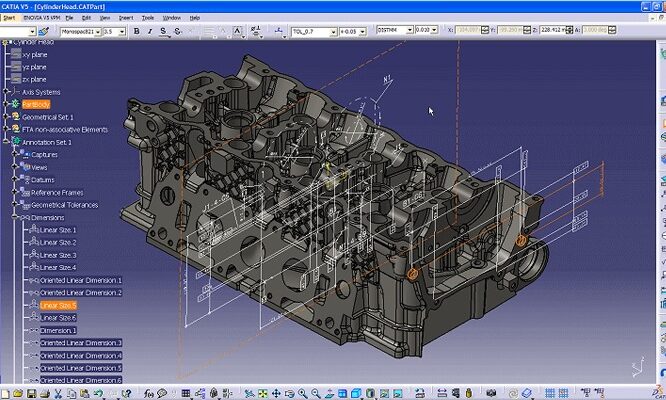CATIA (Computer-Aided Three-dimensional Interactive Application) is another powerful CAD software, widely used in industries like aerospace, automotive, and manufacturing for 3D product design, engineering, and manufacturing. If you’re interested in learning CATIA, here’s a general idea of what a typical course would cover:
Typical CATIA Course Outline:
Introduction to CATIA
Understanding the CATIA interface and workspace
Basic setup and navigation
Introduction to different workbenches in CATIA (Part Design, Assembly Design, Drafting, etc.)
Part Design
Sketching 2D profiles and creating 3D parts
Using tools like Pad, Shaft, Pocket, Hole, Rib, etc.
Parametric design and constraints
Advanced features like surface modeling, thickness, and draft
Assembly Design
Creating and managing assemblies
Using assembly constraints to define relationships between parts
Assembly visualization and interference checking
Surface Design
Working with complex surface modeling tools (e.g., multi-body parts, freeform surfaces)
Application in automotive and aerospace industries for aerodynamics, body panels, etc.
Sheet Metal Design
Creating sheet metal parts
Applying bends, flanges, cuts, and other features specific to sheet metal
Drafting and Documentation
Creating 2D drawings from 3D models
Applying dimensions, annotations, and creating BOM (Bill of Materials)
Understanding and applying drafting standards (ANSI, ISO)
Advanced Assembly Management
Large assembly handling
Assembly optimization
Using skeletons and multi-body modeling
Kinematics and Motion Simulation
Setting up motion studies
Performing basic simulations of moving parts and assemblies
Analyzing motion paths, collisions, and interference
Generative Design and Optimization
Advanced parametric design
Using CATIA’s generative design tools to optimize structures for stress, weight, and material usage
Collaboration and Integration
Data management (e.g., CATIA VPM, ENOVIA)
Importing and exporting files in various formats (STEP, IGES, etc.)
Project Work and Hands-On Practice
Application of concepts to real-world designs
Completing individual or group projects to build a portfolio
Why Choose CATIA?
Industry Leader: CATIA is used by many top engineering and manufacturing companies (e.g., Boeing, Airbus, Ferrari, etc.).
Multi-disciplinary: It supports various disciplines like mechanical, electrical, and systems engineering.
Complex Design: It’s especially useful for projects involving highly complex, large-scale, and precise design work.
Integrated Solutions: CATIA integrates with other Dassault Systèmes solutions for simulation, manufacturing, and lifecycle management.
CATIA Course Benefits:
Industry-Relevant: Learning CATIA opens doors in industries where advanced CAD design and manufacturing processes are crucial.
Expert Instructors: A well-taught CATIA course can give you insights into advanced design principles and real-world applications.
Certification: Being proficient in CATIA often leads to better career prospects, especially in aerospace, automotive, and industrial design fields.
CATIA at Skillverse.in:
If Skillverse offers CATIA courses, it will likely follow a similar structure as the one outlined above, but with a focus on providing practical, hands-on experience. You’d likely have access to projects and assignments that simulate real-world design challenges.
If you’re considering a course in CATIA, you may also want to check if they offer any advanced certification or partnerships with companies in relevant industries.
Instructor

Recent Posts
Recent Comments
Recent Posts
Recent Comments
Archives
Categories
Contact Info
Address
13, 06, 14/3, Block A, Khora Colony, Sector 62, Noida Delhi, near GC public inter college, behind Mohan regency, Deepak Vihar, Noida, Uttar Pradesh 201301
Phone
8684965389
Email
meverse786@gmail.com
